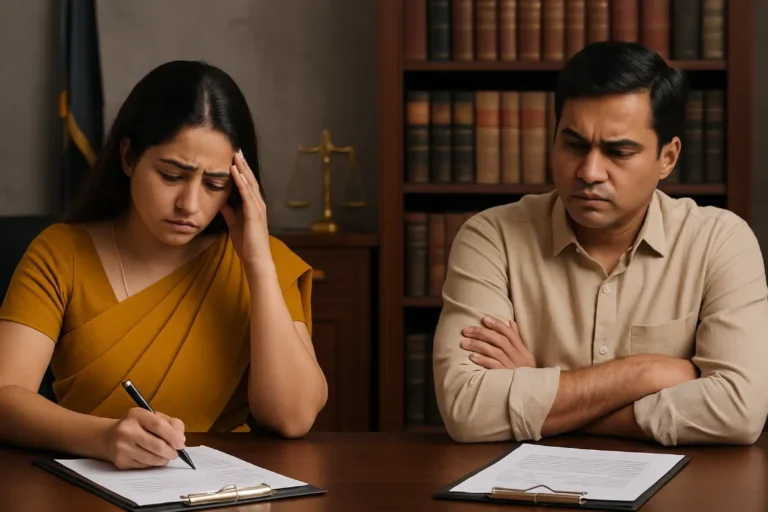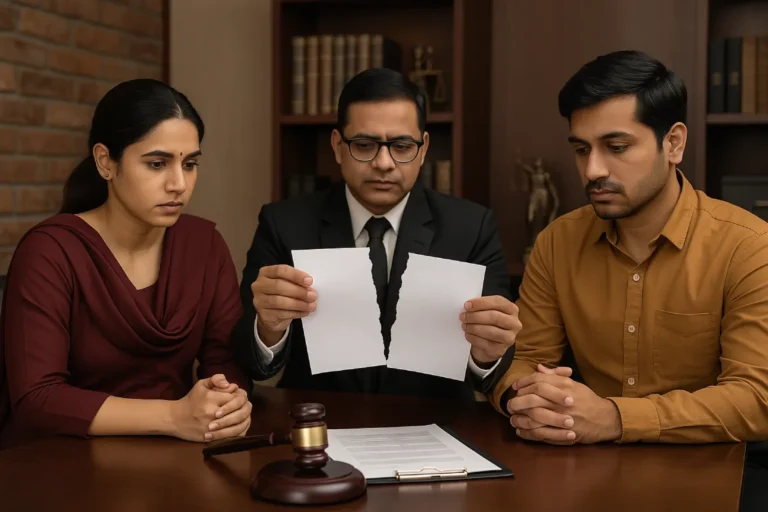Theories of Divorce Under Hindu Law: A Comprehensive Guide
Divorce, the legal dissolution of a marriage, marks the end of a marital union in India, governed by personal laws based on the couple’s community. Under Hindu law, the theories of divorce under Hindu law are primarily outlined in the Hindu Marriage Act, 1955, applicable to Hindus, Buddhists, Sikhs, and Jains. Prior to this Act, Hindu Dharma Shastra viewed marriage as an indestructible bond, offering no divorce options. The introduction of Section 13 revolutionized this by establishing grounds for divorce, reflecting the evolving societal need for legal remedies.
This blog delves into the theories of divorce, with a focus on the fault theory of divorce under Hindu law and the Guilt & Fault Theory of Divorce, exploring how they shape matrimonial dissolution in India.
Concept of Guilt & Fault Theory of Divorce

Understanding the Guilt Theory in Theories of Divorce Under Hindu Law
The Guilt & Fault Theory of Divorce forms the cornerstone of divorce proceedings under the Hindu Marriage Act, 1955. This theory mandates that the petitioner proves the respondent committed a matrimonial offence, justifying the dissolution of marriage. The innocent party seeks relief, while the guilty party bears responsibility. A significant limitation arises if both spouses share fault, leaving no legal remedy for divorce.
The Marriage Laws (Amendment) Act, 1976 expanded the theories of divorce under Hindu law by adding nine grounds based on guilt, including adultery, cruelty, and desertion. This framework ensures that only the blameless spouse can approach the court, emphasizing personal accountability in marital breakdowns.
How Guilt is Determined Under Fault Theory of Divorce Under Hindu Law

For divorce under the guilt theory, three conditions must be met:
- Personal Injury to Marital Relations: The petitioner must show the respondent’s actions caused an irreparable breach, such as adultery or cruelty.
- Absolute Innocence of the Petitioner: As seen in Darshan Gupta v. Radhika Gupta (2013), the petitioner must have “clean hands,” free from contributory fault (Section 23).
- Mutual Fault Precludes Relief: If both parties are culpable, as noted in Samar Ghosh v. Jaya Ghosh (2007), courts cannot grant divorce.
Common Grounds Under Guilt Theory

The Hindu Marriage Act, 1955, lists specific grounds where one spouse is at fault, forming the foundation of the theories of divorce under Hindu law. These grounds are meticulously defined and require the petitioner to substantiate them with evidence. Below is an in-depth explanation of each:
Adultery
This ground is established when one spouse engages in voluntary sexual intercourse with an individual other than their spouse, thereby violating the principle of marital fidelity. The burden of proof lies with the petitioner to demonstrate this act, which fundamentally undermines the trust and exclusivity central to the marital bond. Courts often require concrete evidence, such as witness testimony or circumstantial proof, to uphold this claim, reflecting the seriousness of the offence under the fault theory of divorce under Hindu law.
Cruelty
Defined as conduct that inflicts physical or mental harm upon the other spouse, rendering continued cohabitation untenable. This encompasses a range of behaviors, including emotional abuse, threats, and physical violence. The scope of cruelty has evolved through judicial interpretations, recognizing that mental torment such as constant humiliation or false accusations can be as damaging as physical harm. Cases like Samar Ghosh v. Jaya Ghosh (2007) have emphasized that cruelty must be severe enough to make living together intolerable, aligning with the Guilt & Fault Theory of Divorce.
Desertion
This ground is invoked when one spouse abandons the other without reasonable cause or consent, for a continuous duration of not less than two years, indicating a clear intention to permanently sever the marital bond. Desertion involves both the physical act of leaving and the mental resolve to end the relationship. The petitioner must prove the absence of justification (e.g., financial distress) and the respondent’s intent, making this a complex ground within the theories of divorce under Hindu law.
Insanity or Mental Disorder:
If one spouse suffers from a mental disorder of such nature and extent that the other cannot reasonably be expected to live with the respondent, this constitutes a valid ground for seeking divorce. The disorder must be incurable or severe, impacting the spouse’s ability to fulfill marital duties. Medical evidence and expert testimony are often required to establish this under the fault theory of divorce under Hindu law, ensuring the ground is not misused.
Conversion:
Should one spouse renounce Hinduism and embrace another religion, this fundamental alteration of the marital foundation provides grounds for divorce. This reflects the cultural and religious significance of shared faith in Hindu marriages. The petitioner must prove the conversion was voluntary and not coerced, as this shift can disrupt the marital harmony central to the theories of divorce.
Venereal Disease:
If one spouse is afflicted with a communicable venereal disease that is not contracted from the petitioner, it forms a legitimate basis for seeking dissolution. The disease must be proven to be contagious and incurable, posing a health risk to the innocent spouse. This ground underscores the health-related considerations within the Guilt & Fault Theory of Divorce.
Leprosy:
The Act recognizes virulent and incurable leprosy as a ground for divorce. This provision accounts for the historical stigma and health risks associated with the disease, allowing the unaffected spouse to seek relief. The condition must be medically verified, aligning with the stringent proof requirements of the theories of divorce under Hindu law.
Renunciation of the World:
When one spouse formally renounces worldly life by entering a religious order (such as becoming a sanyasi), this effectively terminates the marital obligations and entitles the other spouse to seek divorce. This ground acknowledges the spiritual dimension of Hindu life, where renunciation signifies a complete withdrawal from marital responsibilities under the fault theory of divorce under Hindu law.
Presumption of Death:
In instances where one spouse has not been heard of as being alive for a period of seven years or more, the law presumes them to be deceased, thereby enabling the other spouse to petition for divorce. This ground is based on practical necessity, allowing the surviving spouse to move forward, reflecting a pragmatic aspect of the theories of divorce under Hindu law.
These grounds highlight the petitioner’s need to prove the respondent’s guilt, a cornerstone of the fault theory of divorce under Hindu law. If both spouses are found culpable, relief is denied, underscoring the theory’s limitations.
Case Law Insights
- Samar Ghosh v. Jaya Ghosh (2007) highlighted the inadequacy of fault-based theories of divorce in irretrievable breakdowns, advocating for reform.
- Darshan Gupta v. Radhika Gupta (2013) reinforced that only the innocent party can seek divorce, emphasizing the “clean hands” doctrine under Section 23(1)(a).
Understanding Fault Theory in Theories of Divorce Under Hindu Law

Difference Between Guilt and Fault Theories
While the Guilt & Fault Theory of Divorce focuses on proving guilt, the fault theory broadly identifies breaches of marital obligations under Section 13(1) of the Hindu Marriage Act, 1955, and Section 27 of the Special Marriage Act, 1954. This includes cruelty, adultery, and desertion, offering a slightly broader lens than the guilt-centric approach.
How Courts Determine Fault
The doctrine of comparative rectitude addresses cases where both spouses are at fault. Courts assess the severity of misconduct, granting divorce to the less culpable party. In Plese v. Plese (1970), this principle mitigated the harshness of recrimination, ensuring equitable outcomes in complex disputes.
Legal Provisions
- Hindu Marriage Act, 1955: Section 13(1) lists nine fault-based grounds, while Section 13(2) adds wife-specific grounds like bigamy and child marriage repudiation.
- Special Marriage Act, 1954: Section 27(1) mirrors these grounds, with Section 34 reinforcing equitable conduct.
These provisions form the backbone of the theories of divorce under Hindu law, balancing marital sanctity with relief.
Modern Perspective on Theories of Divorce Under Hindu Law

Shift Towards No-Fault Divorce
Globally, theories of divorce are shifting from fault-based to no-fault systems, allowing dissolution without proving misconduct, often citing irretrievable breakdown. In India, the Supreme Court, in Naveen Kohli v. Neelu Kohli (2006), advocated for recognizing irretrievable breakdown as a ground, addressing prolonged litigation and emotional distress. The Law Commission supports this, aligning Indian law with modern practices.
Key Judicial Precedents
- Naveen Kohli v. Neelu Kohli (2006) emphasized irretrievable breakdown, citing false accusations as mental cruelty, pushing for no-fault theories of divorce under Hindu law.
Conclusion
The theories of divorce under Hindu law, particularly the fault theory of divorce under Hindu law and Guilt & Fault Theory of Divorce, have shaped matrimonial dissolution with a focus on proving guilt. However, the shift towards no-fault divorce and alternatives like mutual consent (Section 13-B) and mediation offers faster, less adversarial solutions, reducing emotional and financial burdens.
As Aditya & Co. Advocates, we understand the complexities of divorce proceedings. As the best divorce lawyers in Bangalore, we are here to guide you through these challenges, ensuring personalized support and expert legal advice for those in need.







